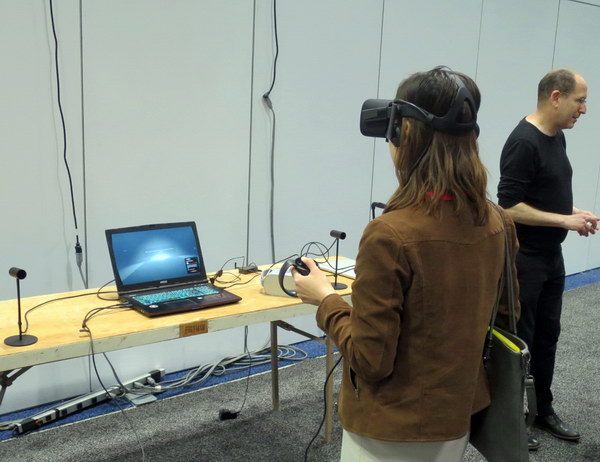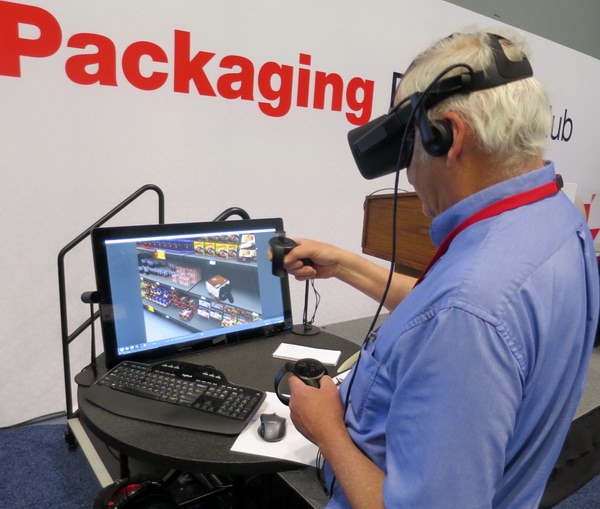On June 13th I attended the six co-located trade shows in New York. ATX East (Automation Technology Expo); MD&M East (Medical Design & Manufacturing); Atlantic Design & Manufacturing; EastPack (Packaging Design and Manufacturing); PLASTEC East (plastics technology); and Quality Expo (Quality Evaluation). Together these six trade shows are called ADM (Advanced Design And Manufacturing) and are said to form “the largest advanced design and manufacturing industry event on the [US] East Coast.”
The show was, indeed, advanced, with stainless steel robots for medical applications that looked like they were right out of a science fiction movie; box folding machines that could, on command, make any size and shape box you needed for your next shipment; vision-based robots playing scrabble; and much more. There were 623 exhibitors from 3D Systems and the Accurate Box Company through Zeiss and Zumbach Electronics Corp. The only display-centric exhibits I saw at the show were companies showing off their IP-65, IP-67 and IP-67 display enclosures for harsh environments.
Epson was showing their vision-guided robots but not their Moverio AR system. (Credit: M. Brennesholtz)
One of the claims of the Augmented Reality and Virtual Reality industries is that training for industrial and medical applications is one of the major current applications of AR and VR. This may be true but I walked up and down every aisle in the trade show and did not see a single booth showing AR or VR systems. Epson was there, for example, showing their industrial robots, but they were not showing their Moverio AR system even though industrial applications of the Moverio are one of their main focuses for the system.
I attended three vendor presentations at the show, “Leveraging Virtual Reality for Industrial Training” presented by Robert Milton at FS Studio; “Emerging Technologies in Packaging + Design” presented by Danielle Sauvé of Danaher; and “Simulation-Driven Design Can Increase Your Profit Margins” presented by Scott Ziemba of Altair Engineering. Neither FS Studio nor Danaher had booths at the show, although Altair Engineering did.
Robert Milton is a 20-year veteran of the industrial and commercial training business and was emphasizing the advantages of AR and VR training. In particular, he said AR/VR training had much higher retention rates than training based on conventional videos. An example he used was of Walmart training about 100K employees in preparation to handle Black Friday crowds. Training was done with VR HMDs in groups of 20 or so, with the intention of avoiding past problems with customer overcrowding to get at black Friday specials. He said most current AR industrial applications used tablets and phones, although the industry is “trending to hands-free headsets.”
 Robert Milton (right rear) from FS Studio demonstrated VR using an Oculus HMD. (Credit: M. Brennesholtz)
Robert Milton (right rear) from FS Studio demonstrated VR using an Oculus HMD. (Credit: M. Brennesholtz)
After his talk, Milton gave a demo of VR using a high-end MSI gaming laptop and an Oculus Rift HMD. The demo would have been more convincing, however, if he had used VR training content as his demo material instead of the built-in Oculus games.
Danielle Sauvé from Danaher discussed the use of several advanced technologies, including VR, in the design of product packaging. According to Sauvé, Chief Marketing Officers typically expect new packaging designs to be in the field within 30 days of the decision to change the packaging but the typical time span is more like 198 days. This is not for a major change – just changing what’s printed on the package without changing the basic package takes that long.
The solution to this vast discrepancy between expectations and reality is, according to Sauvé, using more digital technology including AR/VR, digital color from Pantone, and digital design technologies that avoid the need to retype, rewrite or redraw anything. For example, new text from the CMO should go from his desk through all the people who must approve the change to the product in the store without anyone needing to retype it. This requirement for multiple approvals, according to Sauvé, is one of the reasons why packaging changes take so long.
 Meko’s Matt Brennesholtz lifts a virtual package off a store shelf for examination. (Credit: M. Brennesholtz)
Meko’s Matt Brennesholtz lifts a virtual package off a store shelf for examination. (Credit: M. Brennesholtz)
She also had an Oculus-based VR demo. It involved testing to see how new package designs looked in virtual stores, a concept well in line with what she was trying to sell. Unfortunately the Oculus HMD was not really up to the task. The primary problem was that, in a packaging application like this, you want to be able to read the labels on the package. The resolution of the HMD simply did not allow this. Even labels in very large print, like brand names, were hard to read.
The third presentation I attended was from Scott Ziemba at Altair Engineering, a company that specializes in design software used for “Simulation-Driven Innovation.” He emphasized that the use of technology like virtual prototypes speed the design cycle, reduce product development costs and produce better products. He pointed out that this is not new technology and the automotive industry has been using virtual prototypes for many years. Virtual prototypes, however, do not require virtual reality, which he did not discuss.
The automotive and other industries using virtual prototypes use very sophisticated and very high resolution visualization tools, including very large 2D and 3D displays (Think Sony Crystal LED Displays), CAVEs, high resolution projection, etc. Unfortunately the current generation of HMDs simply doesn’t have enough resolution to fit very well in this ecosystem which needs more “reality” than VR HMDs can provide.
There you have it – a major trade show focusing on innovative industrial and medical technology with hardly a mention of VR and AR. As I learned from Andrew Cochrane at the Immersive Experience Conference at Display Week (Subscription required) there has, in fact, been an uptake of AR and VR technology in industry and it is too early to give up on these markets. The uptake has just been slower than AR and VR enthusiasts expected but has not been ‘slow’ in an absolute sense, not compared to other new communications technologies. –Matthew Brennesholtz

